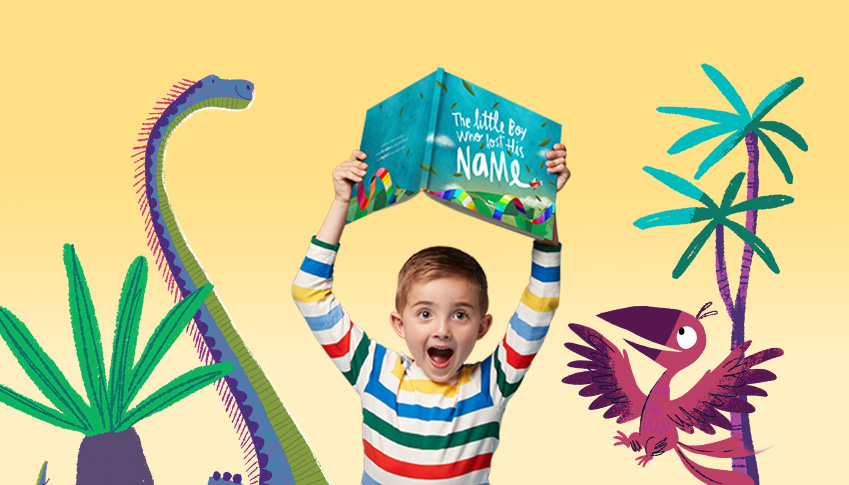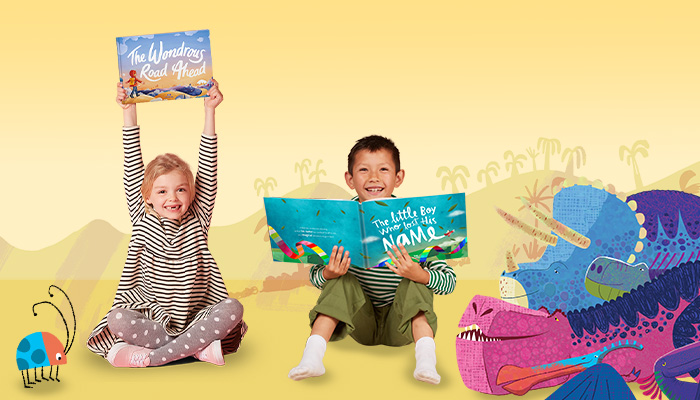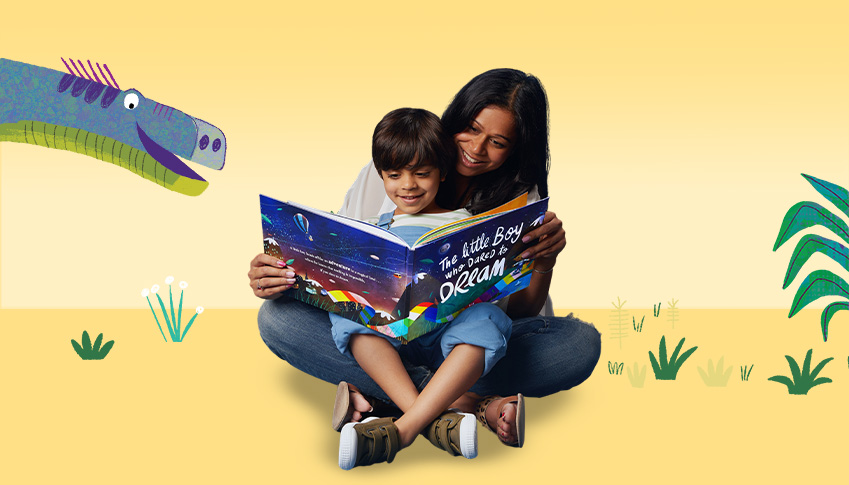Show the little ones in your life that storytime can be all fun and games with this imaginative list of reading activities for kids. Whether you fancy getting creative in the kitchen, doing a spot of role play, creating your own treasure hunts, or introducing small people to the competitive world of wordplay – we’ve got bazillions of ideas to make reading activities out of this world.
Reading out loud
It sounds simple, but a surprising amount of people overlook the impact of putting on a bit of a show. Do the voices! Create a cosy setting! Invite people over to turn it into a real event. We’ve got lots of ideas about how to make this reading activity for kids fantastically fun in its own right.

The terrific treasure hunt
What you’ll need: Pen or pencil, paper, oodles of ideas, precious (to them) objects
Take your cues from the super sleuths and show just how important reading is for solving problems – or even riddles. Hide teddies, dolls, sweet treats, or even random cracker toys that seem to linger around for years in sneaky spots around the home, then ask the children to read your clues to find them. They can be as simple or complicated as you like, from “check your shoes” to “look below the window where the sun sets last”.
Book-themed day
Grab inspiration from the pages of your favourite tales and organise an entire day based on the world it creates. An easy introduction would be all things Roald Dahl: giant peaches for breakfast, dressing up as a witch, a golden ticket treasure hunt, snozzcumber snacks, and crafting the most disgusting twit beards you can imagine.
The gift of storytelling
Surprise (and delight) friends, relatives and loved ones by suggesting to the small person in your life that they offer them the gift of a story. It could either be a written-down snippet of their imagination – complete with illustrations! – or an unforgettable phone or video call reading of a favourite story. Warning: some recipients may get teary.
Make your favourite characters
Bring your child’s best friends to life by making creative masks of the characters they hold so dear. Firstly, re-read the story that is the inspiration for the craft, and then get them to work on a list of key elements they should have: what shape is the mask? Colour? How many eyes does it have? Let their imaginations soar, and then wear the masks to give the tale another read!

Guess the word
What you’ll need: A dictionary, cards, pens or pencils
OK, so this one may seem a bit more academic but it can be a fun exercise, especially if you treat it like a game show. Make up the ‘flashcards’ of words you think your child will know, and then pop them all in a bucket/hat/kitchen sink. Let the child pick out a word, telling you how many letters it has in it, and then ask them as many questions as it takes to arrive at the right answer. To make things harder, they can only say “yes” or “no”. Questions such as, “Is it alive?” or “Do we have one?” are good prompts.
Scrabble (with a twist)
Throw away the rule book and instead use those iconic scrabble pieces for a different kind of game. Ignore the usual seven-letter allotment, and board for that matter, and rather arm your child with a generous amount of pieces (going heavy on the vowels). Then, ask the child to come up with as many words as possible with just those pieces, while you do the same. Write down everyone’s lists and see who emerges triumphant!
Bookish baking
There are two takeaways from this activity, and they’re both brilliant. Firstly, the joy of recreating a literary feast – Hungry Caterpillar buffet or Bruce Bogtrotter chocolate cake, anyone? – and secondly the methodology of reading and following a recipe. PLUS, you get to eat yummy things, too. It’s a win, win… win.
Fold and see
What you’ll need: Pen or pencil, paper
Grown-ups will probably remember this game from school, so now’s the perfect time to introduce it to a new generation. Quite simply, whoever is playing (two or three players is ideal) takes it in turns to write lines of a short story on a piece of paper, which is folded at each turn to keep it a secret – usually following a structure of a ‘beginning’ ‘and then’ results in some kind of narrative. Once an ‘end’ has been established the group opens up the sheet and read out the hilarious tale you’ve come up with together.
Hopscotch spelling
What you’ll need: Chalk, a cleanable floor, multiple players, bundles of energy
Using brightly coloured chalk, mark out four different seven-square hopscotch grids, and write letters in each square. Each player has their own grid. Now, you read out a word, and the kids have to work together to jump to the right squares in the right order to spell it out. Double letters, such as ‘bubble’ need two hops, and so on. Make it even tougher by imposing a time limit…
Set the stage
Select one of the most read books in your mini library and read it again for good measure. Then ask the child to act it out for you, while you watch on from the sofa. Encourage them to make or find any relevant props or costumes and even invite friends to play different parts. Fill up the audience with family members and let the good times roll (don’t forget your camera).
I spy
This classic game can be spun in more ways than granny’s classic knitted jumper. For those that aren’t quite literate yet, asking them to point things out by colour is a good introduction, before building up to questions such as, “I spy your favourite sandwich beginning with c” in the shops and letting them pick out a cheese bap. You can then play with rhymes “I spy something that rhymes with red” at home, for example. The options are endless and it can be tailored to every child’s reading journey.

Silly sounds
We all love a silly voice when reading a story, but this is an accent with a difference. Instead of using this voice for a certain character, try applying it to a certain word. Whenever that word appears, read it in this silly style and watch as the child tries to scan the pages for the next occurrence of amusement. You can add to this and expand it into common phrases, or even more complex words depending on the story in question.
Finish the story
Sometimes a book is so good that you don’t want it to end, and with this reading activity, it doesn’t have to! On the last page, ask the child what they think the characters did next, and begin plotting a sequel together. Encourage them to help write out the next adventures, so that you can then read them together again afterwards. It’s a brilliant way to expand their libraries, vocabulary, and imaginations all in one go.
Flip to it
You’ll need: Paper, pen or pencil, scissors, a stapler
These are flipbooks, with a difference. Instead of making one book of moving images, instead, try making a couple of books with a letter on each page. You can either buy blank flip books for this, or staple small sheets of paper together for the same effect. These books then become the child’s tools for spelling out answers to your questions – be it how to spell certain words (starting simply, and then advancing in complexity as their ability progresses) or even answers to random questions such as “What did you have for breakfast?” By flipping through different physical objects to find the right letters the child is not only critically thinking, but they are also learning through fun. Which is always the best way, right?
Draw a scene from your favourite book
As straightforward as it sounds, this one requires creative thinking and practical drawing ability. Ideally, this would be from an unillustrated tale, so the child could think about how they ‘see’ the book in their mind when reading it. Think Jack emerging from the top of the beanstalk into a world of clouds and faced with a giant door ahead… Encourage re-reading key parts of the story as many times as needed to nail all the details.
